This Artist Painted the Black Radical Response to the George Washington Slaveholder Murals. Here’s Why He Stands Against Destroying Them
In the past week, a simmering dispute over public art at a high school has burst onto the national stage, after the San Francisco School Board voted unanimously to destroy a cycle of New Deal-era murals called the Life of George Washington. The move followed protests by students and parents that images in the work—specifically one panel featuring black slaves laboring on Washington’s plantation, and another depicting the Founding Father standing over the body of a dead Native American—were racist and created a hostile learning environment for minority students.
The controversy first went national in a New York Times op-ed by Bari Weiss, a columnist who has made a career of belittling progressive student activism. It quickly entered the mainstream of right-wing commentary as the latest example of “social justice warrior” excess. But the decision to destroy the work has in recent days attracted much broader opposition, with over 400 artists and academics, including figures like Judith Butler, David Harvey, and Fredric Jameson, signing a letter asking the school board to reverse its decision.
Controversy is, in some ways, built into the George Washington High School murals. Like many artists employed for public works under the New Deal, the creator of the murals, the Russian immigrant Victor Arnautoff (1896-1979), had radical sensibilities. New Deal rhetoric demanded a celebration of national themes, but it was not uncommon for artists to test the limits. In 1934, he had worked with other artists on a cycle of murals at San Francisco’s Coit Tower that had faced censorship for embedding symbols of Communist sympathy, amid the city’s brutal general strike of that year.
The 1936 Life of George Washington murals would seem to be a more straightforward celebration of America’s first president. In the book Victor Arnautoff and the Politics of Art, art historian Robert Cherney argues, however, that the intention was subtly critical: “Washington dominates five of the six smaller murals, but the center of the four largest murals are held by Native Americans, working-class revolutionaries, and enslaved African Americans.” At a time when the text books still taught a sanitized view of the Founding Fathers, Arnautoff was insinuating Washington’s participation in slavery and genocide—though this, Cherney admits, was subtle enough that commentators of the day largely missed any subversive message. The mural’s imagery represents a compromise between official ideology and the artist’s more critical views, which is part of why it can cause such divided reactions.
The murals have proved controversial before. In the ’60s and ’70s, a wave of student activism denounced their images as offensive to black and Native students, demanding that the Life of George Washington be taken down. At that time, the young African American artist Dewey Crumpler was brought in to create a “response mural” to Arnautoff’s cycle, dubbed Multi-Ethnic Heritage, with panels symbolizing the historic struggles of Asian Americans, African Americans, Latin Americans, and Native Americans.
Crumpler, who now teaches at the San Francisco Art Institute, is today a public critic of the proposed destruction of Arnautoff’s Life of George Washington, speaking about the importance of appreciating Arnautoff’s message in a video for the high school’s alumni association, which opposes the destruction. I spoke with him about the history of student struggle over the murals, his own connections with Civil Rights protest and black radical art in the 1960s and ’70s, and why he believes the school board should reverse course.
When did you first become aware of the Life of George Washingtonmurals?
It would be about 1966. I was a junior at that time, graduating in 1967. The school I went to, Balboa High School in San Francisco, had a football game with George Washington High School.
Balboa was an arts magnet, a test case for creating an all-arts high school, with students from all over the Bay Area. Being interested in the arts, I went into the hallway, and I was fascinated by the murals. I was impressed with the scale. I had been reading about the Wall of Respect in Chicago and other murals in places like Detroit.
Then I proceeded on to the football game and and didn’t really think about the mural anymore—although I did remember what I perceived at the time as horrible images of African Americans and the figure of the dead Native American.
So you yourself saw it as an alarming image the first time you saw it?
Initially I did.
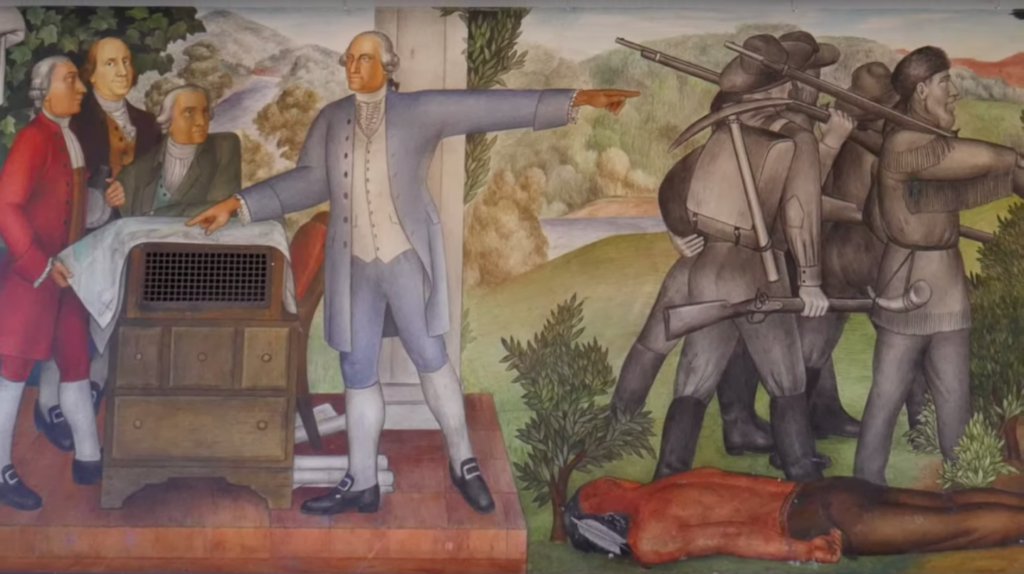
Detail of Victor Arnautoff, The Life of George Washington (1934). Screenshot from GWHS Alumni Assn SF CA on YouTube.
Then, a few years later, there’s a controversy.
African American students, many of whom were Black Panthers, were angry about the depictions and demanded that they be removed without question.
By that time I had been showing my artwork around the city. I’d been involved in Civil Rights demonstrations, and I’d been doing drawings and paintings in relation to them. I had shown at City College and in several other places. San Francisco had an outdoor Civic Center art fair every year, and I had been in that a couple of times. There had been a couple of newspaper articles written about me. I was interviewed on local television.
The backdrop was the riots that were going on in San Francisco. The news media was trying to find some counter to people who were involved in violent activity, and I think they latched onto me because I was interested in art. I also lived near Hunters Point, which is where it was kicking off. It is a black, lower-income neighborhood, where I lived as a kid for a few years.
I used to go to the places where the Black Panther Party was holding neighborhood events. I knew some of the Panther people, like Emory Douglas. I was in the same group with Emory, an organization of African American artists put together by a woman named Evangeline Montgomery. Black artists from around the Bay Area used to meet at her apartment about once a month. Emory was one of the people in that organization initially, before the Black Panther Party really got going.
Before he became minister of culture for the Panthers?
That’s right. In any case, the students saw my work, saw who I was, and they wanted me to make a work. They were demanding that the mural be destroyed and that an African American artist be chosen to replace it.
The students reached out to you?
They did, but the art commission said, “No, we’re not gonna hire a kid to do a mural.”
How old were you?
I was 18 or 19. They were vehement: “We’re absolutely not going to spend a dime on somebody who has never painted a mural of this scale and is just a kid.” They thought that the students at Washington High ought to paint a mural somewhere on the school, and let that be it.
The black students said, “No, we want a professional to do it.” And the art commission replied, “Well, he’s not a professional.”
When the art commission and the board of education decided to delay a decision, the students got angry and threw ink on the Arnautoff mural. After that, the board of education was ready to move. The issue was to save Arnautoff’s murals, whatever that required.
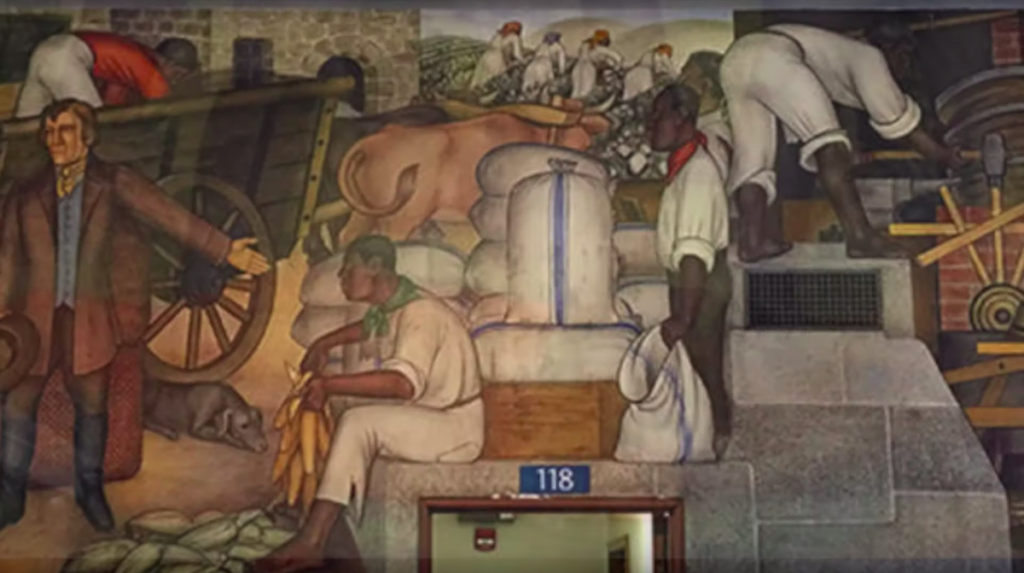
Detail of Victor Arnautoff, The Life of George Washington (1934). Screenshot from GWHS Alumni Assn SF CA on YouTube.
Now there’s this narrative that Victor Arnautoff was trying to get on the record a subversive message about Washington. Was that part of the conversation at that time?
The African American students saw a celebration of George Washington and his slave-owning context. They didn’t understand the nuance of Arnautoff’s engagement. And neither did I when I first saw it.
But once I became involved, I started researching the imagery. Also, by that time I was in college, and I was really paying attention to the history of art and how artists use imagery. At that point, I said very clearly that I would not be a party to destroying the mural. What I will do, I said, is to make a work as great or greater than the mural—that was my arrogance at that time!
I decided I would prove myself by going to Mexico and studying mural-making. Evangeline Montgomery was friends with Elizabeth Catlett and told her that I was coming to Mexico, asking if she could help me find murals so I could learn. So Elizabeth agreed to see me and really set me into motion. At the time, I didn’t even understand how important that meeting was. You know, I’d never heard of Elizabeth Catlett in any of my art classes. I thought she was just another black person making artwork that nobody paid much attention to.
I also met Pablo O’Higgins and [David Alfaro] Siqueiros, two of the greatest muralists living in Mexico. These people helped explain to me what mural painting was. O’Higgins took me into his studio and explained to me Siqueiros’s ideas about how a mural should function, that a mural was not just a picture on a wall.
He helped to show me how to break down a set of images, and explained that a mural should be related to the architecture. He got me to think about how you should study the way people move through the space, where they looked first.
Arnautoff himself had gone to Mexico and studied muralists like Diego Rivera. Pablo O’Higgins was familiar with Arnautoff. I came back with a firm understanding that Arnautoff was really not a person who was trying to venerate George Washington—or rather that he made a picture that venerated George Washington, but from the standpoint of a serious critique.
Understand, most students including myself never knew that George Washington owned slaves. Never. That wasn’t brought up in history class. That’s one reason this was a horrible image for me originally: Arnautoff put slaves next to the president of the United States, and it was that contradiction when I was first saw the mural that threw me.
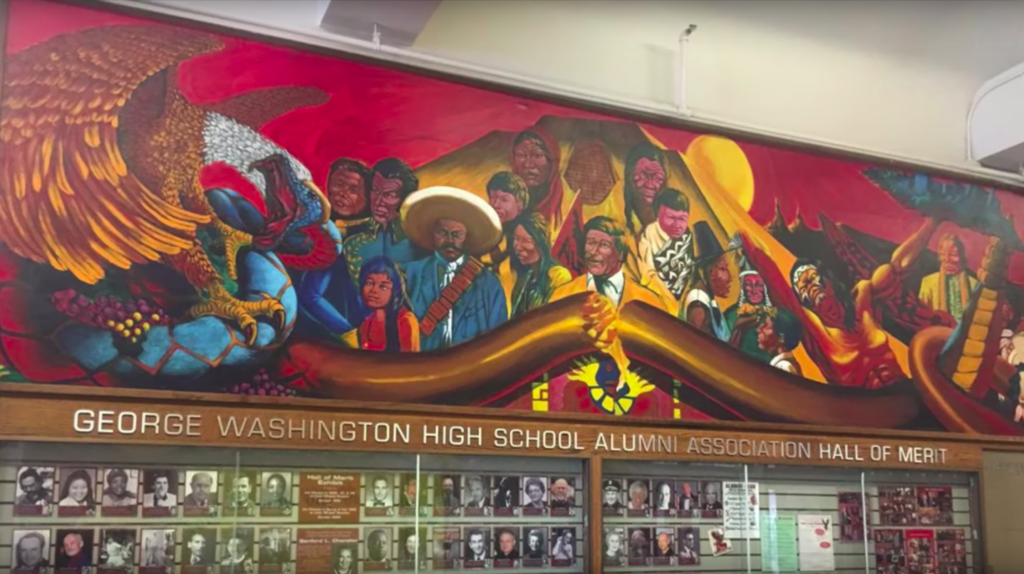
Detail of Dewey Crumpler’s mural, Multi-Ethnic Heritage at George Washington High School. Screenshot from GWHS Alumni Assn SF CA on YouTube.
Tell me about the symbolism of the final mural that you worked out.
When I got back from Mexico, I was interested in trying to set the mural in relationship to the way people move down that long corridor, and the way they came from Arnautoff’s murals into the space where my mural is. You have to walk through a set of doors to see my mural, which is adjacent to Arnautoff’s.
So the first thing you would see when you came through those doors was a Native American holding up Turtle Island, which was Alcatraz. That Native American would be an archetype, with his body stretched out into the sky, not dead but fully alive. And articulated as the blood of the earth, with the red soil, the energy of the earth. Then you would see native peoples.
And then you would see the image of Teotihuacan, which I’d gone to study. And you would see Cesar Chavez and Dolores Huerta, then you would see an image of Simón Bolívar and several Latin Americans. You’d see an image of Mexico. There’s an image of broken chains that links all three sections.
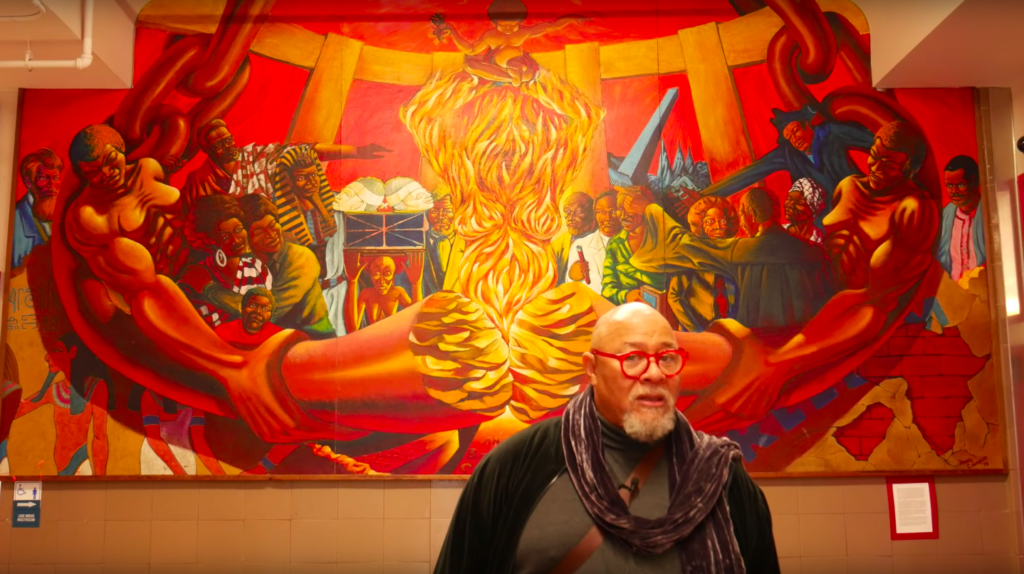
Dewey Crumpler’s in front of the African American panel of Multi-Ethnic Heritage at George Washington High School. Screenshot from GWHS Alumni Assn SF CA on YouTube.
How would you describe its style?
I used archetypes and images of people that would be known to the audience, but done as a kind of part-spiritual, part-specific image.
For example, in the African American mural, there’s an image of a woman as a kind of phoenix, a burning source of creative power, showing that power burning through those chains. That became the central image of the African American panel.
What was the process of making it like?
When I brought back the new designs I had to take them first to the students. I must have gone through 30 meetings over that period, gathering information on what the students wanted to see. Then I had to go and research that material. Then I had to explain to the students that I wasn’t going to just make an illustration of what they wanted, that I was going to make an image based on how I make work, but that I would distill everything they were interested in into a set of images. And that’s what I did.
I had to present that in the form of a maquette, and leave it at the school for students to comment on and look at. Once I got that feedback, I went back and shifted and changed the mural, and then I had to take it to the art commission for approval.
And, of course, no one on the art commission really liked it, because it was political. From their point of view art should never be political, because that made it propaganda, not art. That’s how most of the people on the commission felt, save for Ruth Asawa, whom I knew. She felt it was okay—she just would have preferred for students to make the mural.
Were people disappointed that the Arnautoff mural wasn’t taken down?
There were a few who were absolutely disappointed. After all, my murals were really there to save Arnautoff.
But most of the students agreed with me, because I made it clear: If you want the mural to be destroyed, you will have to get someone else. I explained then—just as I did in that video—what Arnautoff was trying to do. I explained the underlying currents in his mural that you might not be able to decipher if you just look at it quickly.
People are not taught how to read art and artistic imagery. So they don’t understand how it operates, they are trying to look at images literally, not euphemistically, not symbolically.
As a result of the lack of education around art in general, like I was able to get, we have come to a place where art, unless it’s absolutely didactic, is without agency and without significance. And that becomes really a slippery slope that leads to a very dark place.
I thought 50 years ago that it should not be destroyed—because there are elements that are just waiting in the wings to take down other art, and they will use this argument to do exactly that.
Now the school board has voted to destroy the mural. What do you think of that?
I am right with those students. I support their activism. It is just that the outcome here is confused.
I remember that one of the main student leaders from 50 years ago, at the dedication of my murals, he got up and said, “Mr. Crumpler, I’m happy these murals were painted. I believe your murals are important. But I want you to know, and I want this audience to know, that if I understood what Arnautoff was doing, I would never have reacted in the way that I did.” That is exactly what he said. I have remembered these words very, very clearly for 50 years.
It took almost eight years to get my murals painted, because of all of the hell I had to go through. And by that time he, like me, had just graduated. I got my graduate degree, and he had just graduated from college. So he had a different way of seeing the world.
As a young person you are very tender. But as a more mature and knowledgeable person, you realize that the point of art is to make you think, to make you see that the world is dynamic. Your confrontation with difficulty is the very thing you need as a child, particularly in an educational environment, so you can learn how to deal with those difficulties that you are going to run into throughout your life.
If you run away from history, you’ll never change history. You have to confront history. Art is a teaching tool. That’s why every culture in the world uses it.
All the conversations and emotions stirred up by a work of art are part of what that work of art means. My mural is part of the Arnautoff mural, part of its meaning, and its meaning is part of mine. If you destroy his work of art, you are destroying mine as well.
Ben Davis has been artnet News's National Art Critic since 2016. He is the author of '9.5 Theses on Art and Class' (Haymarket, 2013), and was an editor of 'The Elements of Architecture' (Taschen, 2018), which began as the catalogue to the 2014 Venice Architecture Biennial. Recent essays have appeared in the books 'Public Servants: Art and the Crisis of the Common Good' (MIT Press, 2016) and 'The Future of Public Space' (Metropolis, 2018). His writings have been featured in Adbusters, The Brooklyn Rail, e-Flux Journal, Frieze, New York, The New York Times, Slate, The Village Voice, and many other venues. In 2019, Harvard’s Nieman Journalism Lab reported that he was one of the five most influential art critics in the United States, and the only one to write for an online publication. Twitter. Facebook.
Follow artnet News on Facebook:
Want to stay ahead of the art world? Subscribe to our newsletter to get the breaking news, eye-opening interviews, and incisive critical takes that drive the conversation forward.

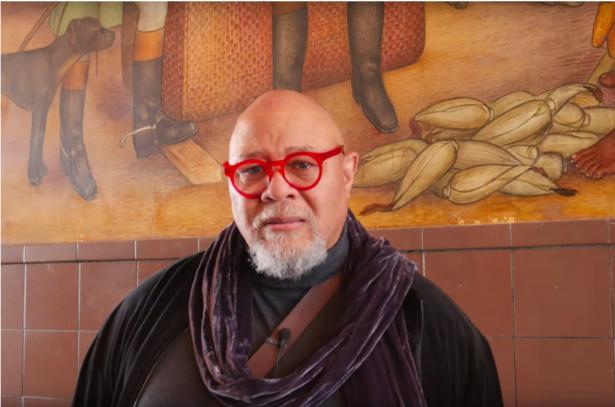
Spread the word